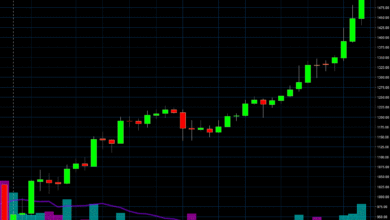US Dollar Fragility: BIS Issues Dire Warning on Markets

The fragility of the US dollar has become a pressing concern as the Bank for International Settlements (BIS) issues stark warnings regarding global economic instability. U.S. policy upheaval is shaking the foundations of financial trust, thereby diminishing the dollar’s traditional safe-haven appeal amidst rising economic uncertainty. As international markets adjust to increased volatility and unpredictability, fears of de-dollarization grow stronger, indicating that the dollar’s dominance may be waning. BIS General Manager Agustín Carstens highlighted this precarious situation, likening current conditions to a historic stress test for the dollar. With economic stability hanging in the balance, it is crucial for policymakers to address these underlying vulnerabilities to restore confidence in the currency and the broader financial system.
The concept of dollar fragility refers to the vulnerabilities currently influencing the stability of the United States currency in the global arena. Recent warnings from key financial institutions, including the BIS, signal that rising geopolitical tensions and unpredictable policy shifts are casting shadows over the dollar’s reliability. Economic instability, marked by inflationary pressures and the threat of de-dollarization, is challenging longstanding perceptions of the dollar as an unshakable safe haven. As experts enumerate the risks faced by the currency, including growing disenfranchisement of global trust, the urgency for comprehensive reforms becomes even more pronounced. It is evident that in this rapidly evolving financial landscape, understanding the intricate nuances of dollar robustness is essential for navigating potentially tumultuous economic waters.
The Fragility of the US Dollar Amidst Global Uncertainty
The US dollar, once viewed as the bastion of financial stability, is currently experiencing unprecedented stress as global economic conditions swiftly deteriorate. The recent dire warnings from the Bank for International Settlements (BIS) underline the dollar’s fragility, exacerbated by chaotic US policy decisions that have sent ripples through international markets. With U.S. policymakers navigating uncharted waters, the once rock-solid perception of the dollar as a safe haven is now being called into question, leading investors to reassess their positions in light of economic uncertainty.
As economic instability rises, the dollar’s status as the world’s primary reserve currency faces significant challenges, especially concerning the trend of de-dollarization. Countries are increasingly looking to diversify their reserves and reduce dependency on the dollar, driven by fears of sanctions and political unpredictability from within the U.S. This evolving landscape not only threatens the dollar’s dominance but also highlights the urgent need for reforms that restore confidence in the U.S. economic framework.
BIS Warning: The Dire Consequences of US Policy Upheaval
The recent warning by Agustín Carstens of the BIS highlights a crucial turning point in the global economy. He articulated that the chaotic shifts in U.S. policy have precipitated a crisis of confidence among international investors, leading to volatility that could destabilize markets further. The interplay of fiscal expansion proposals, tariffs, and potential punitive measures against foreign investors adds layers of uncertainty that make predicting the future of the economic landscape increasingly complex.
Furthermore, the instability prompted by U.S. policy upheaval causes a domino effect that affects not only the domestic economy but also global partners who are trying to navigate their pathways amid uncertainty. The longstanding trust in the dollar is faltering, necessitating immediate attention from lawmakers and financial authorities to stabilize conditions. Without a coordinated response, the repercussions could include heightened market volatility and a further erosion of confidence in U.S. financial instruments.
Economic Uncertainty and the Future of Global Markets
Economic uncertainty, as stressed by the BIS, has significant ramifications for global markets. The ripple effects of the dollar’s decline in trust manifest in higher volatility, especially as emerging economies wrestle with the implications of potentially reduced investment flows. Structural vulnerabilities, such as poor productivity rates and an over-reliance on non-bank financial institutions (NBFIs), underscore the fragility of both the U.S. and global financial systems, necessitating urgent reforms.
Additionally, the economic equilibrium is further threatened by inflationary pressures resulting from disrupted trade policies. As nations grapple with rising costs and diminishing returns, finding common ground for regulatory changes becomes imperative. Stakeholders must evaluate the broader implications of policy decisions on both domestic recovery and international relations to foster a resilient global economy.
De-dollarization: A Rising Trend in the Global Economy
The trend of de-dollarization is becoming increasingly prominent as nations around the world seek to reduce their reliance on the U.S. dollar amidst widespread economic uncertainty. Governments are exploring alternative currencies and even digital assets to mitigate risks associated with holding dollars. This shift is not merely a response to adverse U.S. policies but also a strategic maneuver to protect national interests and promote stability in domestic economies.
Countries such as China and Russia are leading the charge in this paradigm shift, implementing policies aimed at promoting their currencies in international trade. The implications of a world less dependent on the dollar could reshape the global financial landscape, resulting in a more multipolar currency system. Such a transformation could trigger profound changes in geopolitical dynamics, with long-term consequences for the U.S. economy if the dollar’s reserve status falters.
The Impact of Tariff-Driven Trade Fragmentation
Tariff-driven trade fragmentation presents significant challenges to economic growth, as highlighted by recent analyses from financial experts. Increased tariffs not only strain relationships between trading nations but also create barriers that hinder effective economic cooperation. The repercussions are felt broadly, particularly in sectors reliant on global supply chains, which are now facing higher costs and disrupted production schedules.
Moreover, the pursuit of protectionist policies appears to be a double-edged sword. As countries impose tariffs in hopes of bolstering local industries, the unintended consequences often lead to rising inflation that compounds existing economic woes. Policymakers must recognize the importance of maintaining an open trade environment to foster growth, urging dialogue to dismantle barriers and restore trust in the global trading system.
The Role of Non-Bank Financial Institutions (NBFIs) in Economic Instability
Non-bank financial institutions (NBFIs) are increasingly scrutinized as potential harbingers of economic instability amid the evolving landscape of finance. With their rising prominence, particularly in areas traditionally dominated by banks, these institutions present unique challenges for regulators striving to maintain market stability. The lack of comprehensive oversight can lead to systemic risks, especially when NBFIs engage in speculative practices without adequate safeguards.
Addressing the implications of NBFIs requires a careful balance between fostering innovation and ensuring regulatory parity with traditional banks. As rapidly evolving technologies and financial products emerge, the regulatory framework must adapt to prevent unexpected market disruptions. The establishment of robust guidelines around the operations of NBFIs is crucial in fortifying the resilience of the financial system and preserving confidence among investors.
Reforming Public Infrastructure to Support Sustainable Growth
Investing in public infrastructure is essential for driving sustainable economic growth, particularly in times of uncertainty. The BIS emphasizes the correlation between robust infrastructure and productivity improvements, which are critical for bolstering long-term economic resilience. Enhanced infrastructure not only facilitates trade and commerce but also provides a foundation for innovation and job creation, further stabilizing the economy.
Policymakers must prioritize infrastructure projects that address pressing societal needs while creating an enabling environment for businesses. By promoting public-private partnerships and addressing regulatory bottlenecks, governments can kickstart lagging initiatives that enhance economic agility. As structural vulnerabilities persist, a committed emphasis on building and maintaining quality infrastructure will play a vital role in stabilizing the economy and fostering investor confidence.
Navigating the Challenges of Digital Financial Innovations
The rise of digital financial innovations signifies a transformation in the global economy that brings both opportunities and challenges. As technologies such as blockchain and artificial intelligence redefine the landscape of finance, the necessity for regulatory bodies to keep pace becomes ever more urgent. Central banks are particularly tasked with balancing the promotion of innovation while safeguarding the financial system against potential systemic risks.
Moreover, the potential introduction of central bank digital currencies (CBDCs) could reshape monetary policy frameworks and influence the dollar’s status in global markets. While offering advantages such as enhanced transaction efficiency and transparency, CBDCs also pose questions about privacy, security, and regulatory oversight. Engaging stakeholders across the financial spectrum will be essential for developing an inclusive strategy that maximizes the benefits of digital innovations while mitigating their risks.
Building a Resilient Framework for Future Economic Crises
To safeguard against future economic crises, there is a pressing need for a resilient financial framework that adapts to the changing landscape. Insights from the BIS underline the importance of addressing foundational weaknesses, such as fiscal imbalances and increasing securities market volatility. Establishing a robust and transparent regulatory framework will not only enhance market trust, but it will also attract investment at a time when confidence is wavering.
A multi-faceted approach that includes strengthening cooperation among regulatory bodies, enhancing financial literacy, and ensuring equitable access to financial resources will empower economies to withstand shocks. By proactively confronting challenges such as inflation and trade fragmentation, both policymakers and industry leaders can collectively work towards cultivating a resilient economic environment capable of navigating the uncertainties of the future.
Frequently Asked Questions
What are the implications of US dollar fragility on the global economy?
US dollar fragility can lead to increased economic instability globally, as the dollar’s role as a primary reserve currency means that its depreciation affects international trade and investment. The precariousness highlighted by BIS warnings indicates that any significant downturn in the dollar’s value could exacerbate financial trust issues and provoke market volatility.
How does US policy upheaval contribute to US dollar fragility?
US policy upheaval creates uncertainty, which erodes confidence in the dollar. The BIS cautions that drastic policy changes, such as unexpected tariffs and fiscal expansions, amplify this fragility by making markets more volatile and less predictable, undermining the dollar’s traditional status as a safe haven.
What role does the BIS warning play in understanding US dollar fragility?
The BIS warning serves as a critical alert regarding US dollar fragility by indicating the current risks within the global economic framework. It underscores the potential consequences of policy shifts and highlights the necessity for reforms to restore stability and trust in the financial system.
In what ways can economic uncertainty exacerbate US dollar fragility?
Economic uncertainty leads to a lack of investor confidence, which can cause the dollar to lose its safe-haven status. Factors such as inflationary pressures and structural vulnerabilities contribute to this scenario, as outlined in the BIS report, signaling potential long-term impacts on the dollar’s value.
What is the impact of de-dollarization on US dollar fragility?
De-dollarization efforts can significantly amplify US dollar fragility by reducing the dollar’s dominance in global trade. This shift creates vulnerabilities for the dollar, especially when countries seek alternative currencies or trading frameworks, which can destabilize its value and acceptance in international markets.
How does global economy instability relate to US dollar fragility?
Global economy instability is intrinsically linked to US dollar fragility, as disruptions in one major economy can ripple through others. The BIS warnings emphasize that interconnected financial systems mean that uncertainties surrounding US economic policies can lead to broader instability, affecting the dollar’s strength.
What measures can policymakers take to mitigate US dollar fragility?
Policymakers can implement credible reforms addressing the fundamental economic drivers of US dollar fragility. The BIS suggests enhancing market agility, reducing trade barriers, and ensuring regulatory parity between banks and NBFIs as critical steps to strengthen the dollar’s position and restore confidence.
What future risks contribute to US dollar fragility according to the BIS?
The BIS identifies several future risks to US dollar stability, including the rise of non-bank financial institutions (NBFIs), challenges from digital currencies, and major technological innovations. These factors create new complexities in the financial landscape that can further weaken trust in the dollar.
How does tariff-driven trade fragmentation affect US dollar fragility?
Tariff-driven trade fragmentation increases inflationary pressures and limits economic flexibility, contributing to US dollar fragility. As highlighted by the BIS, such measures often fail to achieve desired results and instead deepen existing structural challenges, creating an unstable economic environment.
What is the significance of central bank digital currencies in the context of US dollar fragility?
Central bank digital currencies (CBDCs) may play a significant role in addressing US dollar fragility by providing a more stable and trusted medium for transactions. The BIS suggests that CBDCs could enhance financial security and efficiency, helping to restore confidence in the dollar amidst growing economic challenges.
| Key Point | Details |
|---|---|
| US Dollar’s Status | The US dollar is facing challenges regarding its safe-haven status due to increasing market volatility and trust erosion. |
| BIS Warning | The Bank for International Settlements (BIS) issued a warning regarding the impact of U.S. policy changes on global financial stability. |
| Policy Disruption | U.S. policy upheaval, including unexpected tariffs and fiscal changes, has created an environment of uncertainty in markets. |
| Economic Fragmentation | Tariff-driven trade fragmentation is deepening inflationary pressures and undermining economic flexibility. |
| Future Risks | Emerging challenges from non-bank financial institutions (NBFIs) and digital innovation are reshaping the financial landscape. |
Summary
US dollar fragility is becoming increasingly prominent as market dynamics shift and global uncertainties rise. The recent warnings from the BIS highlight the urgent need for policymakers to address structural vulnerabilities and re-establish trust in the currency. This situation underscores the critical importance of effective reforms that will bolster the dollar’s position in a changing financial environment.




